As part of the art exhibition Time / Image, the Krannert Art Museum and Art Theater Co-Op are joining forces to bring two films and a night of video art to C-U. Time / Image, on view until Apr. 23rd, focuses on French philosopher Gilles Deleuze’s concept of “time-image” in post-World War II cinema, making it only natural to have a film series with a similar theme. The Time / Image film series at the Art Theatre is also a great way of bringing the discussion from the galleries out into the community. With two more film series nights left, let’s get a rundown of what’s in the gallery and what will be on the silver screen in the coming weeks.
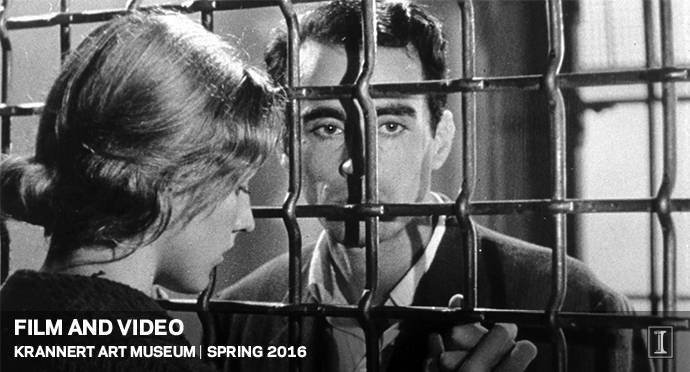
Contemporary art and modern cinema have a tendency to go hand in hand. The artworks presented in Time / Image offer a great range of discussion. In my previous review of the exhibition, I talked extensively about Simeon Allen’s Screen II (edit) (2015). Other highlights from Time / Image were:
-
 A Lexicon of Dusk by Ruth Robbins (2009-2015) presents postcards of different, ambiguous scenes at an ephemeral moment. Each postcard defines or presents a word related to or synonymous with dusk or twilight, and on the reverse, the coordinates along with time and date are given by the artist. The viewer is invited to take a postcard (or two) to take with them, and share (or not) the captured moment with another person in another location.
A Lexicon of Dusk by Ruth Robbins (2009-2015) presents postcards of different, ambiguous scenes at an ephemeral moment. Each postcard defines or presents a word related to or synonymous with dusk or twilight, and on the reverse, the coordinates along with time and date are given by the artist. The viewer is invited to take a postcard (or two) to take with them, and share (or not) the captured moment with another person in another location. -
Andrea Geyer’s Imagine to be here, right now (Comrades of Time) (2011; digital C-prints) captures letters written to Weimar Republic era philosophers with portraits of women. In the same space, Geyer’s Insistence (2013), a single-channel video installation, showcases women in modern art in New York during the 1920s and 1930s part of an intellectual and institutional project. Both works examine the concept of the archive, a collection of objects and their representation over time, in different ways.
-
An interesting piece juxtaposing famous figures from different time periods is Lorraine O’Grady’s The First and the Last of the Modernists, Diptych 1-4 (2010). Each diptych or pair displays a large, tonal image of Michael Jackson and Charles Baudelaire in either red, green, blue, or black tones. O’Grady states both men were “unrivaled creatives and emblematic of modern icons.” At a glance, the pairing seems unusual, but after more thoughts about each icon of their period, you realize the two may have more in common than you first thought.
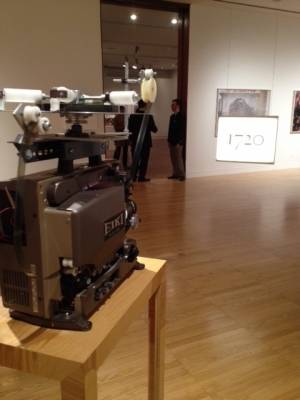
Other works like 1720 by Matthew Buckingham (2009; installation) use a 16mm film on a continuous loop and a projector to compound the distant past, the recent past, and the present. All of the pieces show how deeply entrenched our concept of a chronological time is and how easily time can be manipulated or referenced in other ways. However, a contemporary art exhibition about the moving image would not be complete without a few video installation pieces.
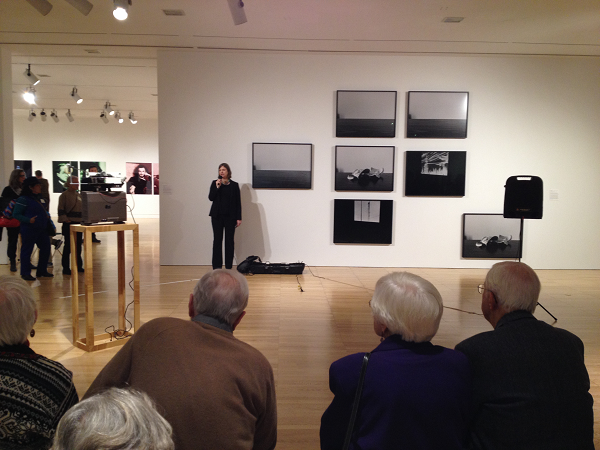
Three video installation pieces are presented to visitors to experience as part of Time / Image. In the East Gallery, Isaac Julien’s Fântome Afrique (2005) is a 17 minute long film about migration, memory, and time. Fântome Afrique references formal cinematic techniques and relevant cinema works, but Julien manipulates both sound and image to challenge the chronological and spatial perspective.
Across the Rose Gelvin Noel Gallery, two more video installation pieces are presented as part of Time / Image. Raqs Media Collective’s An Afternoon Unregistered on the Richter Scale (2011) is a roughly four minute long, looped single-channel video of a single archival image. Through light manipulation, elements in Examining Room of the Duffing Section of the Photographic Department of the Survey of India (1911) come to life. A ceiling fan in the image begins to slowly turn. Then the light seems to shimmer like daylight through a curtain. The touches are subtle and require the viewer to spend more than the average 15 to 20 seconds to look at the artwork.
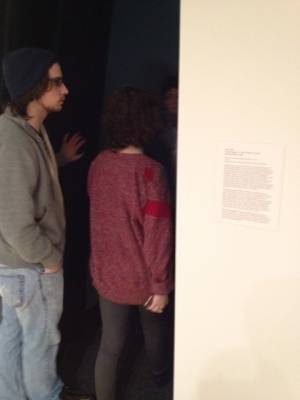 Opposite An Afternoon Unregistered is a second Allan deSouza* piece. This installation relies on a narrative written by deSouza* about a traumatic event. The text scrolls idly upward on the screen while a narrator calmly reads from Joseph Conrad’s novella Heart of Darkness (1899). At first, you think the scrolling text is what you are hearing, but then you focus on the words and realize that they don’t match. The juxtaposition of the subject, when realized by the viewer, is jarring but understandable once realized. Chairs are available in this gallery in order to stop and absorb the information, but the dark room feels uninviting.
Opposite An Afternoon Unregistered is a second Allan deSouza* piece. This installation relies on a narrative written by deSouza* about a traumatic event. The text scrolls idly upward on the screen while a narrator calmly reads from Joseph Conrad’s novella Heart of Darkness (1899). At first, you think the scrolling text is what you are hearing, but then you focus on the words and realize that they don’t match. The juxtaposition of the subject, when realized by the viewer, is jarring but understandable once realized. Chairs are available in this gallery in order to stop and absorb the information, but the dark room feels uninviting.
In trying to reach out and engage the community, KAM is hosting a discussion after each movie playing at the Art Theatre for the Time / Image series. On Monday Mar. 7th, the Art Theater presented Pickpocket by Robert Bresson. The film exemplifies Deleuze’s concept of “time-image”: he theorized that character motion or object motion through time presented in a film would break down. Specifically, he felt that this break occurred after the Second World War when cinema began to explore how to directly and indirectly represent time through images. Deleuze highlighted this concept in his work titled Cinéma 2, L’Image-temps (1985), and the concept has been used to explore how images, moving and still, can capture a moment in time. The film showing was followed by a question and answer discussion with guest speakers.
Tonight, KAM and the Art Theater will show A Night of Video Art: Works by Semiconductor & the Otolith Group. Semiconductor and The Otolith Group are both artist groups who use film to examine social, environmental, and cultural issues. Four videos will be presented: Some Part of Us Will Have Become and All the Time in The World by Semiconductor (Ruth Jarman & Joe Gerhardt) and People to be Resembling and Otolith III by the Otolith Group (Anjalika Sagar & Kodwo Eshun). Curator Amy L. Powell of KAM will lead a post-film discussion.
Next Monday, March 21st KAM and Art Theater will show Cemetery of Splendor, the Palme d’Or winning film about a volunteer caring for one of the soldiers suffering from a mysterious illness in a clinic. The film plays with time and image by overlaying memories and visions on the main storyline visuals. Once again, Powell will lead a discussion along with Austin McCann, General Manager and programmer of the Art Theater.
Time / Image explores time as both a linear and nonlinear subject along with how we visually represent time through a variety of media. Whether it’s manipulating the film itself or manipulating how we understand time, the exhibition and film series plus the talks and performances offer a deep exploration of contemporary art and film.
———
Both films will start at 7:30 p.m. and cost $10 for Adults and $8.50 for Annual Members. In case you missed the Raqs performance back in February and don’t have plans to see the last two films in the film series, you can also attend an artist talk with featured artist Andrea Geyer on April 5th at 5:30pm at KAM in room 62.
* Editor’s note: In the first version published, we corrected this portion, which originally credited Isaac Julien, which is a mistake.
About Sarah Keim:
Sarah Keim is a contributing writer to Smile Politely’s Arts section. She’s a bit of a recluse on social media, but you might bump into her out in the wilds of C-U. Frequent sightings occur at coffee shops, farmers markets, and hockey games.








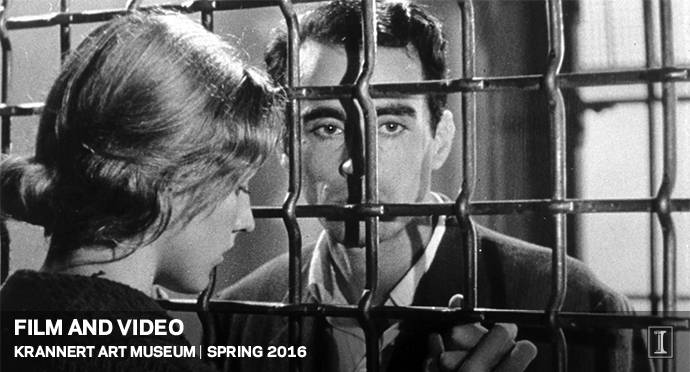
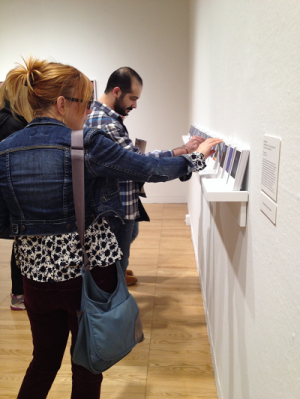 A Lexicon of Dusk
A Lexicon of Dusk 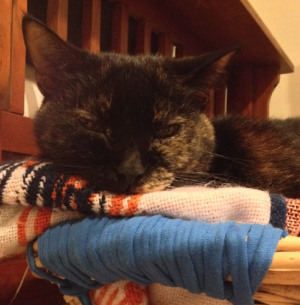 About Sarah Keim:
About Sarah Keim: